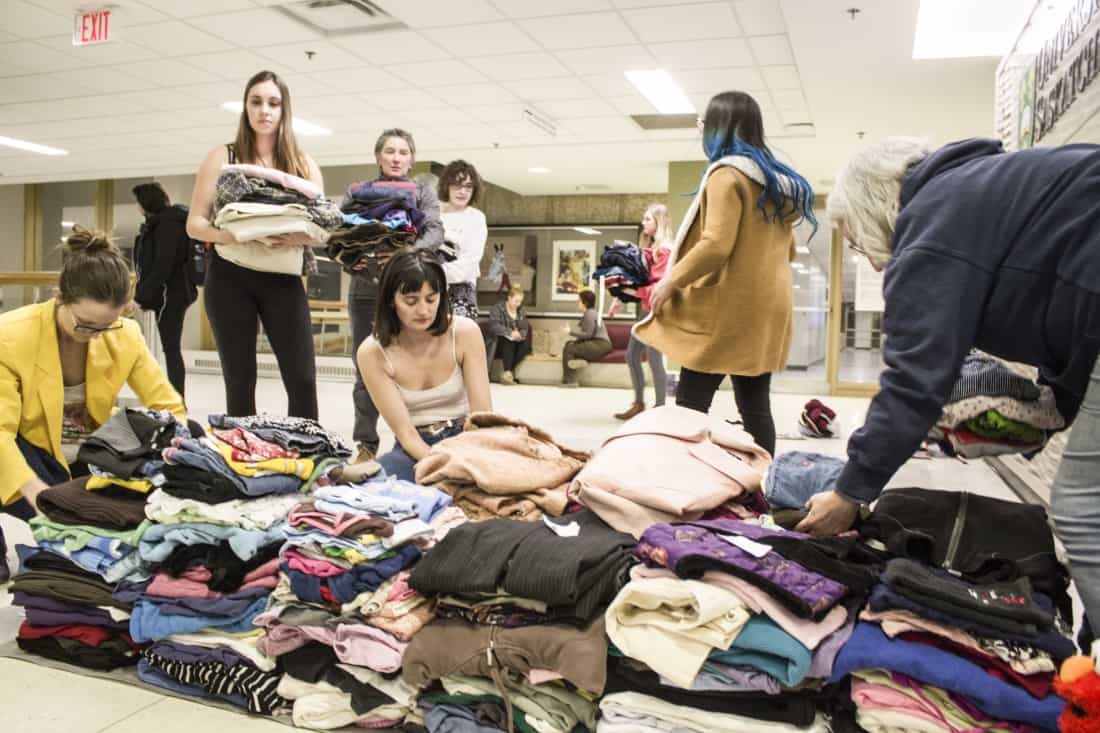
Students in WGST 324 organize their installation, in Arts until Feb. 26.
A third-year women’s and gender studies class collaborated with local artist Mindy Yan Miller to create an art installation with discarded used clothing, which will be featured in the Arts Building on the second floor until Feb. 26.
The course, WGST 324: Rebels With A Cause — Feminism and the Visual Arts, has collaborated with multiple local artists this term. The course examines contemporary feminist art since the 1970s, focusing on how women have contributed to the art world during this time. On Feb. 12, Miller facilitated a Sorting Party, which she conducts for her installations, where the 32 students enrolled in the course organized the used clothes for the current art installation.
For Shirley Cuschieri, a fourth-year psychology student, the experience of sorting through bags of clothing made her consider the issue of social inequality.
“Feeling the clothes in your own hands made the issue very tactile. Some families in Saskatoon might only be able to afford these second-hand clothes, but others can afford to buy brand new clothes. Everyone has a unique relationship with clothes,” Cuschieri said.
Miller’s Sorting Party installations involve a group of participants that assist her in sorting through bags of used clothing and grouping them by the country they were produced in. The items are then folded and assembled in a piled structure for display. Students in the course say that the installation serves as a commentary on socio-economic and racial injustices.
Jesmin Subba, a fourth-year women’s and gender studies student, discusses the contrast between current events and the Sorting Party installation.
“The Olympics are happening right now, and we are celebrating and cheering for so many countries. Just like the Olympics, this art is also bringing all of the countries together, but in a very different way,” Subba said.
Joan Borsa, a faculty member in the department of art and art history and the women’s and gender studies program, created WGST 324 over 10 years ago to examine the ways in which the contributions of female artists have not been appreciated.
“Rebels With A Cause offers a lens that focuses on what it [is] that women artists are frequently rebelling against — both in the art world and the broader social and economic world — and how they articulate that rebellion in unique, compelling and frequently inspiring ways,” Borsa said.
To demonstrate the experiences of female artists in Canada beyond a slideshow presentation, Borsa prioritized bringing local artists into the course curriculum. This term, the class has heard guest lectures from Miller, as well as Ruth Cuthand, Amalie Atkins and Lisa Birke.
Miller is a Canadian artist who works with large masses of found materials including clothing, human hair and Coca-Cola cans. She investigates themes of labour, loss, identity and commodification in her art and frequently works in a variety of mediums, most notably sculpture, performative pieces and installations.
Borsa discusses how knowledge about social issues can be communicated using alternative methods, like Miller’s installations, as opposed to traditional written texts.
“In this project, we consider clothing as a type of material text or form of knowledge equivalent to books. The project is grounded in readings and related artworks, which look at the garment industry, our relationship to clothing, the over-production of cheap clothes and the increasing amount of discarded clothing flooding places like Value Village,” Borsa said.
The installation will be on display at the top of the Arts Building ramp for two weeks for students to read about the topic on the accompanying posters. This project is meant to bring attention to the overconsumption practices of Saskatoon and the world, which is something Renée Prefontaine, a fourth-year education student, has started to do after taking part in Miller’s installation.
“Three hours of sorting clothes really puts the garment industry and labour into perspective.”
—
Sydney Boulton
Photo: Gabbie Torres